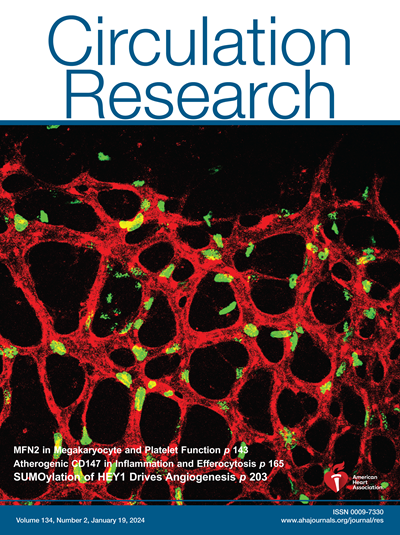Macrophage-Derived CCL24 Promotes Cardiac Fibrosis Via Fibroblast CCR3.
IF 16.2
1区 医学
Q1 CARDIAC & CARDIOVASCULAR SYSTEMS
引用次数: 0
Abstract
BACKGROUND Inflammation is a significant risk factor and contributor to the development of cardiovascular disease by driving both adaptive and maladaptive responses to cardiac injury. Macrophages are the most abundant immune cells in the heart and play an important role in the remodeling of cardiac tissue. Cardiac resident macrophages are integral components of the myocardium, where they have key roles in the response to inflammation, tissue injury, and remodeling. However, the precise mechanisms by which cardiac resident macrophages regulate remodeling in heart failure remain poorly understood. METHODS AND RESULTS We have identified a subpopulation of cardiac resident macrophages that expresses high levels of the CCL24 (C-C motif chemokine ligand 24) during pressure overload-induced injury. Following transverse aortic constriction, CCL24 deficiency ameliorated cardiac fibrosis, suggesting a pathological role for CCL24 and revealing that cardiac resident macrophages are a heterogeneous population with dichotomous roles in mediating cardiac remodeling. Mechanistically, CCL24 directly activated cardiac fibroblasts through its sole receptor, CCR3 (C-C chemokine receptor type 3), in an inflammation-independent process. The engagement of the CCR3 receptor promoted fibroblast proliferation and activation via PI3K-induced Akt phosphorylation and the release of the key fibrotic cytokine TGF (transforming growth factor) β. To determine the in vivo role of CCR3 in fibroblast activation during cardiac remodeling, we used CRISPR/Cas9 to generate fibroblast-specific CCR3-deficient mice. Following pressure overload, fibroblast-specific deletion of CCR3 improved cardiac function and reduced fibrosis to a degree comparable to that observed in CCL24-deficient mice. Notably, administration of a CCL24-blocking antibody or a CCR3 antagonist enhanced cardiac function in pressure-overloaded mice, underscoring the CCL24-CCR3 axis as a promising therapeutic target for heart failure. CONCLUSIONS Macrophage-derived CCL24 aggravates fibrosis via the CCR3 receptor, impairing cardiac function in heart failure.巨噬细胞来源的CCL24通过成纤维细胞CCR3促进心脏纤维化。
研究背景:炎症是心血管疾病的重要危险因素,通过对心脏损伤的适应性和非适应性反应来促进心血管疾病的发展。巨噬细胞是心脏中最丰富的免疫细胞,在心脏组织的重塑中起着重要作用。心脏巨噬细胞是心肌不可分割的组成部分,它们在炎症反应、组织损伤和重塑中起着关键作用。然而,心脏巨噬细胞调节心力衰竭重构的确切机制仍然知之甚少。方法和结果:我们已经鉴定出在压力过载引起的损伤中表达高水平CCL24 (C-C基序趋化因子配体24)的心脏巨噬细胞亚群。在主动脉横缩后,CCL24缺乏改善了心脏纤维化,提示CCL24的病理作用,并揭示心脏巨噬细胞在介导心脏重塑中是一个异质性的群体,具有双重作用。在机制上,CCL24通过其唯一受体CCR3 (C-C趋化因子受体3型)直接激活心脏成纤维细胞,这是一个不依赖炎症的过程。CCR3受体的参与通过pi3k诱导的Akt磷酸化和关键的纤维化细胞因子TGF(转化生长因子)β的释放促进成纤维细胞的增殖和活化。为了确定CCR3在心脏重塑过程中成纤维细胞激活中的体内作用,我们使用CRISPR/Cas9技术生成了成纤维细胞特异性CCR3缺陷小鼠。在压力过载后,成纤维细胞特异性缺失CCR3可改善心功能并减少纤维化,其程度与ccl24缺陷小鼠相当。值得注意的是,ccl24阻断抗体或CCR3拮抗剂可增强压力过载小鼠的心功能,强调CCL24-CCR3轴是治疗心力衰竭的有希望的靶点。结论巨噬细胞源性CCL24通过CCR3受体加重纤维化,损害心力衰竭患者的心功能。
本文章由计算机程序翻译,如有差异,请以英文原文为准。
求助全文
约1分钟内获得全文
求助全文
来源期刊

Circulation research
医学-外周血管病
CiteScore
29.60
自引率
2.00%
发文量
535
审稿时长
3-6 weeks
期刊介绍:
Circulation Research is a peer-reviewed journal that serves as a forum for the highest quality research in basic cardiovascular biology. The journal publishes studies that utilize state-of-the-art approaches to investigate mechanisms of human disease, as well as translational and clinical research that provide fundamental insights into the basis of disease and the mechanism of therapies.
Circulation Research has a broad audience that includes clinical and academic cardiologists, basic cardiovascular scientists, physiologists, cellular and molecular biologists, and cardiovascular pharmacologists. The journal aims to advance the understanding of cardiovascular biology and disease by disseminating cutting-edge research to these diverse communities.
In terms of indexing, Circulation Research is included in several prominent scientific databases, including BIOSIS, CAB Abstracts, Chemical Abstracts, Current Contents, EMBASE, and MEDLINE. This ensures that the journal's articles are easily discoverable and accessible to researchers in the field.
Overall, Circulation Research is a reputable publication that attracts high-quality research and provides a platform for the dissemination of important findings in basic cardiovascular biology and its translational and clinical applications.
 求助内容:
求助内容: 应助结果提醒方式:
应助结果提醒方式:


